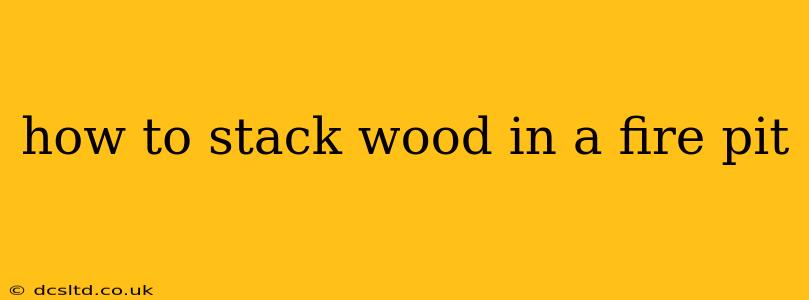Building a roaring fire in your fire pit is a rewarding experience, but achieving that perfect burn depends heavily on how you stack your wood. A well-stacked fire pit creates efficient airflow, leading to a cleaner burn, less smoke, and longer-lasting flames. This guide will walk you through the best techniques for stacking wood in a fire pit, addressing common questions along the way.
What Kind of Wood is Best for a Fire Pit?
Before we dive into stacking, let's briefly discuss wood selection. Hardwoods like oak, maple, and hickory burn longer and produce less smoke than softwoods like pine or fir. However, softwoods can be good kindling to get the fire started. The ideal scenario is to use a mix of both, using the softwood to ignite the hardwood. Always ensure your wood is dry; damp wood produces excessive smoke and burns poorly.
How to Build a Fire: The Foundation
The key to successful fire stacking is creating a stable base for the fire to build upon. Here’s how:
-
Tinder: Start with a small pile of tinder in the center of your fire pit. This could be dry leaves, pine needles, small twigs, or commercial fire starters. The tinder needs to catch easily and ignite the kindling.
-
Kindling: Arrange small, dry sticks (kindling) around the tinder, creating a teepee or log cabin structure. This allows air to circulate freely, facilitating combustion. Gradually increase the size of the kindling sticks as the fire grows.
-
Fuel Wood: Once the kindling is burning well, carefully add larger pieces of firewood, building outwards from the center. Avoid completely covering the flames, as this will smother the fire.
Different Fire Stacking Techniques
Several methods exist for stacking firewood effectively. Here are two popular and highly effective techniques:
The Teepee Method
This is a classic and simple method, ideal for smaller fire pits and quick fire building.
- Base: Create a small pile of tinder in the center.
- Leaning: Lean small pieces of kindling against the tinder, forming a teepee shape.
- Building: Gradually increase the size of the kindling sticks as the fire grows. Add larger pieces of fuel wood around the kindling, again leaning them against the structure.
The Log Cabin Method
This method is best for larger fires and longer burns, offering excellent air circulation.
- Base: Lay two larger pieces of kindling parallel to each other.
- Cross-Layering: Place two more pieces of kindling on top, perpendicular to the first two, creating a square.
- Building: Continue layering kindling and then fuel wood in this cross-pattern, gradually increasing the size of the pieces as the fire burns.
How Much Space Should Be Between Logs?
Sufficient space between logs is crucial for good airflow. Avoid tightly packing the wood, leaving gaps for oxygen to reach the flames. The spacing should allow air to circulate freely without allowing the flames to spread too widely.
How Do I Keep My Fire Burning Overnight?
To maintain a fire overnight, you need to create a larger fire with a substantial amount of fuel wood, stacked using either the teepee or log cabin method, focusing on larger, drier pieces of hardwood. Consider using some larger logs underneath. You may also need to add more fuel wood during the night, depending on the wood's dryness and weather conditions.
What if My Fire is Producing Too Much Smoke?
Excessive smoke usually indicates insufficient airflow or damp wood. Ensure your wood is dry and that there is enough space between the pieces for proper air circulation. If using a teepee method, ensure the structure is not too tight.
Conclusion
Mastering the art of fire stacking takes practice, but by following these techniques and understanding the principles of airflow and fuel, you can create a beautiful, efficient, and long-lasting fire in your fire pit. Remember, safety is paramount—always keep a safe distance from the fire and have a bucket of water or sand nearby. Enjoy your fire!
